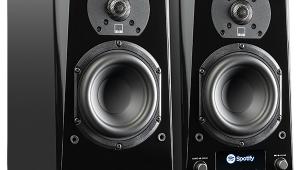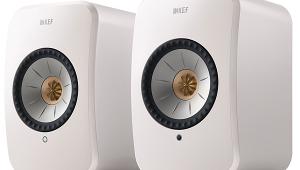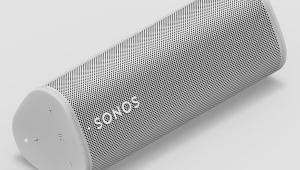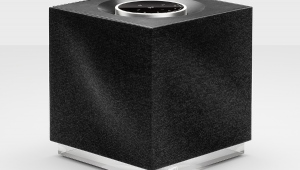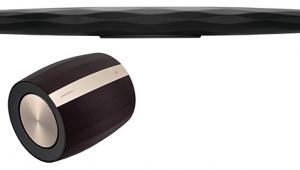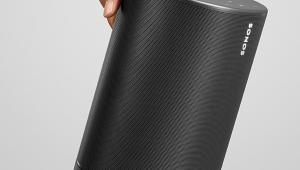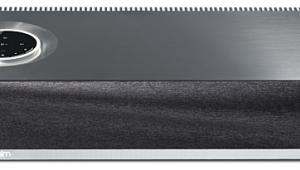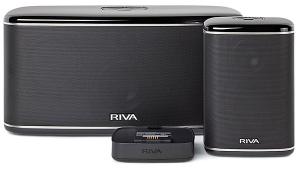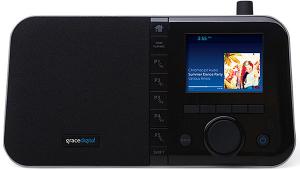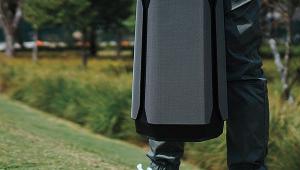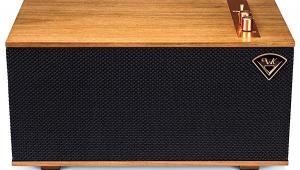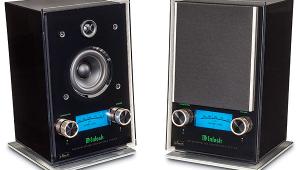JBL Authentics L8 Wireless Speaker

AT A GLANCE
Plus
Fantastic sound with pleasantly forward bass
Lots of bonus features (including optional cordless Qi device charging)
Sexy retro design
Optical input
Minus
Bass could be a bit much for those who love flat response
THE VERDICT
Perfect for folks with small apartments where space is tough to come by, the L8 is versatile, adaptive, and attractive enough to be front and center of a small audio setup.
How It Connects: Bluetooth, NFC, DLNA, Wi-Fi, Airplay, ⅛” analog, optical.
A true bookshelf speaker packed with extras, the JBL Authentics L8 is the largest model we’ll discuss here, measuring about 26 x 10 x 13 inches and weighing around 16 pounds. So whereas the Go and the One offer portability, the L8 is made to stay put. That said, if you can’t take the L8 with you, there are a lot of ways to bring your audio to the L8. With AirPlay, DLNA, and Bluetooth, if you have a device that can connect wirelessly, the L8 will communicate. Plus, it has an ⅛-inch analog input as well as an optical port. This last part is pretty fantastic, as those looking to save space can have the L8 easily double as a soundbar for their TV with a connection to the television’s optical audio output.
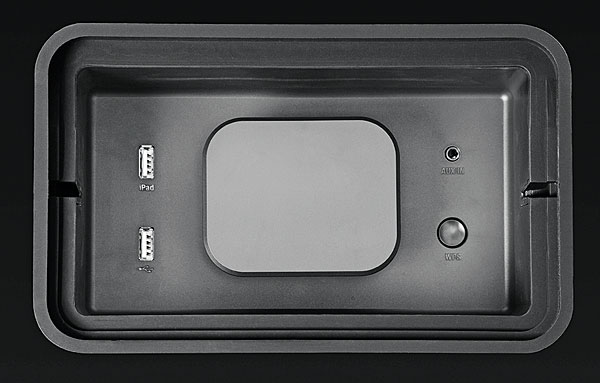
While you’re streaming your music, you can also charge your device, and the L8 offers many options here as well. Two USB ports are tucked neatly inside the speaker behind a little panel on the top. In addition, a Qi plate (sold separately) allows those of you with Qi wireless charging modules installed on your gear to get your power-up sans cord. Futuristic as that option is, the L8 has a distinctively retro design, with a grid-like waffle foam speaker grille that’s directly reminiscent of JBL’s ‘70s-era L100 Century speaker. In fact, of all the speakers in this test, I found the JBL’s styling—with its grille, spindle platform feet, and clean stainless-steel backlit dials—to be the most appealing overall.
How Does It Sound?
With two 1-inch tweeters, and two 4-inch woofers, the L8 packs a punch. Ported on the bottom, the speaker has a low end with a pleasant, if intense, bump that gives it a well-formed and full-bodied low end that doesn’t get overly thuddy or muddy. The mids sound relatively even, and the highs are clean and distinct without a sizzling edge to the sibilance. The L8 is equipped with JBL’s proprietary Clari-Fi software, which is designed to intuitively sense the specific encoding algorithm of various digital music codecs and compensate for each individual form of compression. The speaker is adroit with rock and pop and still has enough dexterity to handle orchestral music and opera with ease. Buyers who like a bit of a boost or sizzle in the high end might want to look elsewhere, however, as the L8’s top frequencies sound flat to slightly rolled off. The overall profile is warm, lush, and a pleasure to listen to. Be warned, however: At high volumes in smaller rooms, I found the bass could resonate, potentially annoying neighbors or flatmates (though this can be a problem with any bass-capabable speaker system).
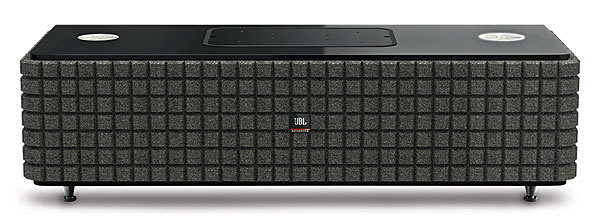
The Bottom Line
Ready to take over for your small TV speakers, fuel your next dance party, or provide the backdrop for an intimate dinner party, the L8 is as great a choice for someone just starting out as it would be for hifi enthusiasts looking to expand their listening options.
Specs
4 in woofer (2), 0.98 in tweeter (2); 26.2 x 9.66 x 13 in (WxHxD); 16 lb
Test Bench
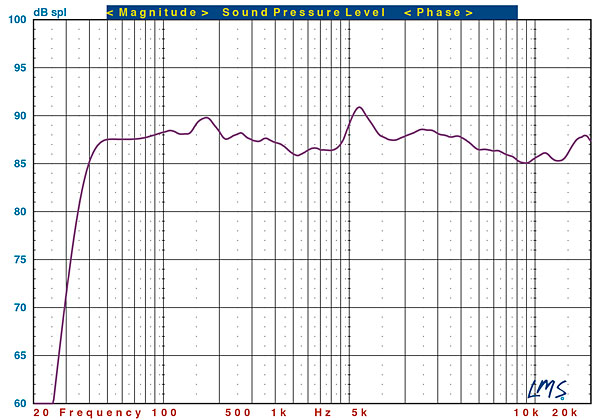
This graph shows the quasi-anechoic (employing close-miking of all woofers) frequency response of the L8 Sound System (purple trace). The left channel was measured with grille at a distance of 1 meter.
The L8 Sound System’s listening-window response (a five-point average of axial and +/–15-degree horizontal and vertical responses) measures + 3.34 /– 2.48 decibels from 200 hertz to 10 kilohertz. An average of axial and +/–15-degree horizontal responses measures +3.50/–2.00 dB from 200 Hz to 10 kHz. The –3dB point is at 45 Hz, and the –6dB point is at 39 Hz.—MJP
- Log in or register to post comments


Barber shops near me
Barber shops near me
Barber shops near me
Barber shops near me
Barber shops near me
Barber shops near me
Barber shops near me
Barber shops near me
black Barber shop near me
black Barber shop near me
black Barber shop near me
black Barber shop near me
black Barber shop near me
black Barber shop near me
black Barber shop near me
black Barber shop near me
black Barber shop near me





The latest version of the Minecraft APK game is available, bringing you new features and finding treasure faster.

